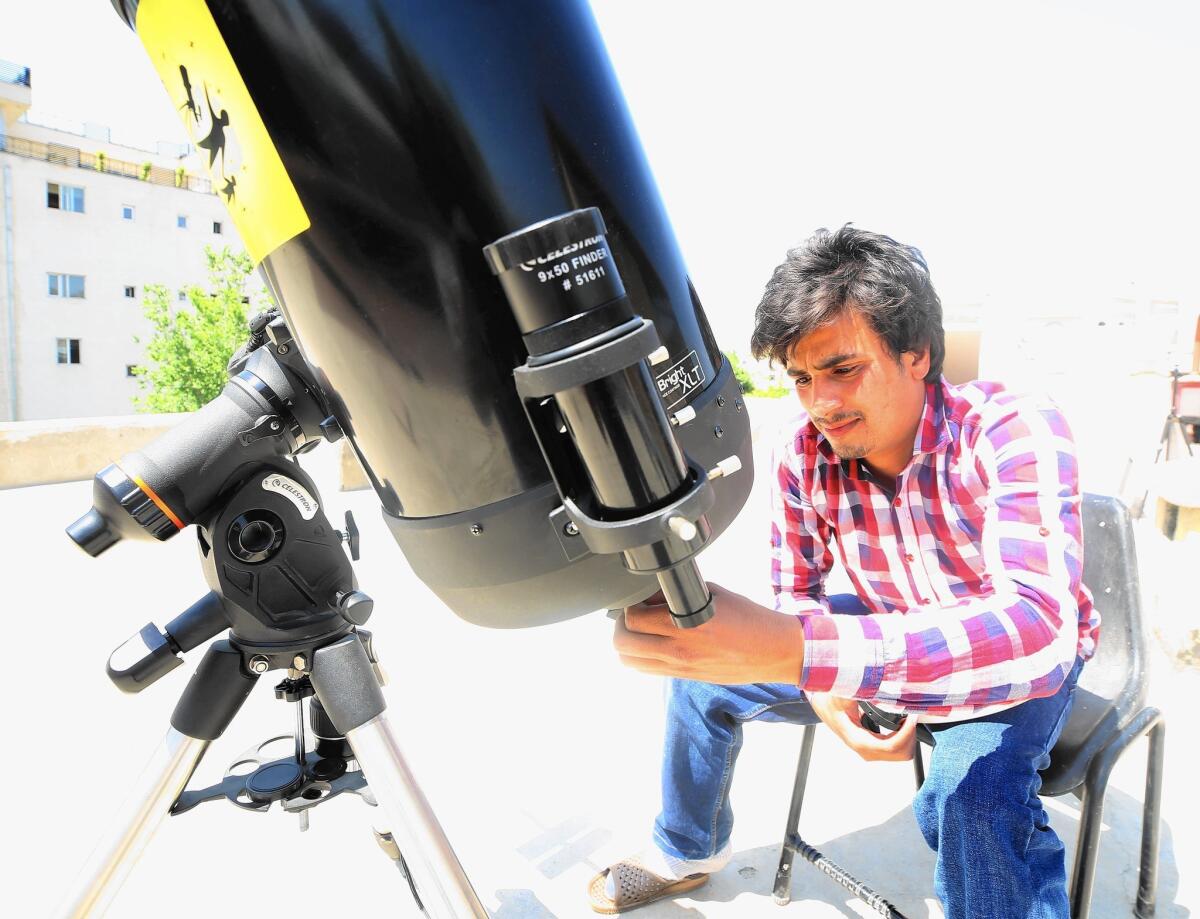In war-torn Afghanistan, astronomer sees hope and promise in the study of the heavens

- Share via
Reporting from KABUL, Afghanistan — Ibrahim Amiri was finishing a hamburger one day in 2011 when a headline in the newspaper wrapping caught his eye.
He had to read it a second time to make sure he wasn’t dreaming. But it was true: Neil Armstrong, one of his lifelong heroes, and two other Apollo astronauts were visiting Afghanistan to rally U.S. troops.
Amiri, an amateur astronomer who had built his own telescope out of spare parts as a teenager, tried to contact the U.S. Embassy to arrange a meeting. But it was too late: The astronauts had left.
Still, he didn’t let disappointment set in. He saw it as a sign that validated a fascination with the stars that began during his childhood in a refugee camp in Pakistan.
Amiri, now 26, was 6 or 7 when he saw the Hale-Bopp comet streaking across the sky above the camp in Peshawar, Pakistan, where he was born.
“I remember it had this long tail that shone in the night sky,” Amiri said. “It was unlike anything I had ever seen before.”
He began to seek out books on astronomy. His interest grew when his family returned in 2003 to Afghanistan, where television stations had reemerged since the fall of the Taliban government, and cellphones and the Internet were just starting to accelerate the flow of information from the outside world.
One day in 2003, while watching television, Amiri saw something that changed how he looked at the universe: pictures of the Mars surface. Amiri was struck by the similarities between the Red Planet and his own.
“It looked so similar to Earth,” he said. “There were mountains and deserts, even the sun in the sky.”
In 2007, after years of study, he built his own 100-millimeter refractor telescope out of spare parts he found around the city. Following diagrams in his books, he fit a magnifying glass at the end of a stovepipe and then adjusted the lens to bring images into focus.
“When I first saw the moon, with its craters, it was astonishing,” he said.
::
Amiri’s telescope is an example of the ingenuity of young Afghans who have overcome war, economic uncertainty and a struggling education system to pursue their dreams.
Last year, a 30-year-old self-trained engineer built a solar-powered motorbike that he hopes will help improve mobility for disabled people in a country where few streets or structures are built with them in mind.
A robotic excavator designed by a teenager in Logar province recently caught the attention of former President Hamid Karzai, who gave the child an award and held him up as an example to tribal elders of the merits of education.
In a country without a space program, Amiri clung to a moonshot dream of becoming an astronaut. When he enrolled in 2009 at Kabul University, where there was no astronomy program, he studied physics, which NASA considers a related field.
Though he never got to meet Armstrong, last year he met another hero, Abdul Ahad Mohmand, who became the first Afghan to travel into outer space when he spent nine days aboard a Russian space station in 1988.
“It was a proud moment,” Amiri said. He and other amateur astronomers “were able to show him our own telescopes,” he said.
Now Amiri, in addition to his day job as a translator and language tutor, has begun teaching a new generation of young Afghans about the heavens. He has joined a group of fellow amateur astronomers and helped develop a textbook for school-age children. The group hopes it will replace the more outdated texts in the country’s schools.
The astronomers also recently purchased a mobile planetarium for the rooftop of their offices in west Kabul, hoping to pique the interests of schoolchildren — boys and girls — in astronomy.
Last summer the Consortium for Undergraduate Research and Education in Astronomy, a program run by a professor at Kenyon College in Ohio, invited Amiri to the United States. He attended seminars at Griffith Observatory in Los Angeles and studied the spectrum of light emitted from sunspots using the Snow Solar Telescope on Mt. Wilson in the San Gabriel Mountains.
Amiri believes that for a nation constantly caught in conflict, the growth of astronomy could give young people something universal to study, helping to deter those vulnerable to the propaganda of insurgents.
“When you see that the Earth itself is just a little speck in the universe,” he said, “all of these differences — the borders, the languages — everything else seems so insignificant.”
Latifi is a special correspondent.
More to Read
Sign up for Essential California
The most important California stories and recommendations in your inbox every morning.
You may occasionally receive promotional content from the Los Angeles Times.










